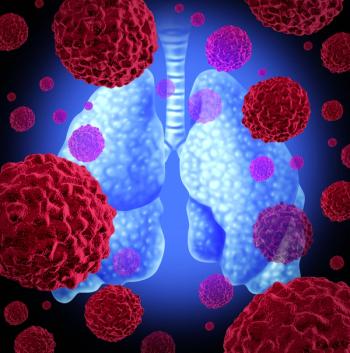
- ONCOLOGY Vol 15 No 3
- Volume 15
- Issue 3
State of the Art of Non-Small-Cell Lung Cancer in the New Millennium
Lung cancer is the leading cause of cancer death worldwide, with mortality rates in most developed countries ranging from 35 to 95 fatalities per 100,000 in men and 10 to 20 deaths per 100,000 in women.[1] Non-small-cell lung cancer is the most
Lung cancer is the leading cause of cancer death worldwide, withmortality rates in mostdeveloped countries ranging from 35 to 95 fatalities per 100,000 in men and 10to 20deaths per 100,000 in women.[1] Non-small-cell lung cancer is the most commonlung malignancy, accounting for more than 75% of all lung cancers. At time ofdiagnosis, approximately 60% of non-small-cell lung cancer cases are locallyadvanced or metastatic, and more than 85% of patients diagnosed with thisneoplasm die of their disease. The 5-year survival of patients presenting withlocally advanced disease is about 10%, and for those with stage IV disease,survival drops to 1%.[2] These dismal outcomes have not changed over the past 2decades, and thus the need for more effective treatment is obvious.
During the past 20 years, clinical investigators have attemptedto develop chemotherapeutic regimens that effectively prolong survival andprovide palliation for patients with non-small-cell lung cancer. Recentmeta-analyses have shown that platinum-based chemotherapy combined with thoracicradiotherapy (TRT) improved survival in the setting of locally advanced non-small-celllung cancer, as compared with radiotherapy alone. Combinations of platinum andTRT increased median survival by 3 months and demonstrated a 5% increase in5-year survival.[3] Furthermore, data from randomized trials of concurrentchemoradiation in unresectable stage III non-small-cell lung cancer haveindicated significant improvements in survival, and several ongoing single-armphase I/II trials assessing new agents in combination with TRT have shownencouraging results.
In the late 1990s, several new agents emerged from clinicaldevelopment and demonstrated activity against non-small-cell lung cancer,including gemcitabine (Gemzar), paclitaxel (Taxol), docetaxel (Taxotere),vinorelbine (Navelbine), and irinotecan (CPT-11, Camptosar). In a 1998 article,Bunn and Kelly[4] reviewed phase II studies of these new agents and listedsingle-agent objective responses of ³ 20% (range: 13%-27%), with mediansurvival duration of about 40 weeks (range: 34 to 38 weeks), and 1-year survivalof 40% (range: 24% to 52%) (Table 1). When these agents were evaluated incombination with platinum compounds, the overall response rates ranged from 35%to 47% with a median survival of 34 to 57 weeks; average 1-year survival rangedfrom 35% to 61% (Table 2).
In addition, a number of novel targeting therapies are underinvestigation in non-small-cell lung cancer, including matrixmetalloproteinase inhibitors, epidermal growth factor inhibitors, vascularendothelial growth inhibitors, farnesyl transferase inhibitors, cyclin dependentkinase inhibitors, and gene therapy (Table 3). However, at present, it isreasonable to consider that the newer chemotherapy agents used in combinationwith a platinum compound are the most effective regimens in patients withadvanced non-small-cell lung cancer. Of these recently approved agents,gemcitabine has provoked considerable interest, and it is the purpose of thissymposium to clarify gemcitabine’s role in the treatment of non-small-celllung cancer.
References:
1. Cancer Rates And Risks. National Institutes of Health,National Cancer Institute. Available at http://rex.nci.nih.gov/NCI Pubinterface/raterisk/rates38.html
2. Mountain CF: Revisions in the International System forStaging Lung Cancer. Chest 111:1710-1717, 1997.
3. Pritchard RS, Anthony SP: Chemotherapy plus radiotherapycompared with radiotherapy alone in the treatment of locally advanced,unresectable, non-small-cell lung cancer: A meta-analysis. Ann Intern Med125:723-729, 1996. Published erratum appears in Ann Intern Med 126:670, 1997.
4. Bunn PA Jr, Kelly K: New chemotherapeutic agents prolongsurvival and improve quality of life in non-small-cell lung cancer: A review ofthe literature and future directions. Clin Cancer Res 4:1087-1100, 1998.
Articles in this issue
almost 25 years ago
Novel Approaches in the Treatment of Non-Small-Cell Lung Canceralmost 25 years ago
Triplet Combination Chemotherapy and Targeted Therapy Regimensalmost 25 years ago
Gemcitabine and Nonplatinum Combinations in Non-Small-Cell Lung Canceralmost 25 years ago
Gemcitabine for the Treatment of Non-Small-Cell Lung Canceralmost 25 years ago
Gemcitabine in Combination With New Platinum Compounds: An Updatealmost 25 years ago
Treatment of Elderly Patients With Non-Small-Cell Lung Canceralmost 25 years ago
Optimizing Chemoradiation in Locally Advanced Non-Small-Cell Lung Canceralmost 25 years ago
Irinotecan in Gastrointestinal Malignanciesalmost 25 years ago
Update on Chemotherapy for Advanced Colorectal CancerNewsletter
Stay up to date on recent advances in the multidisciplinary approach to cancer.






























































































